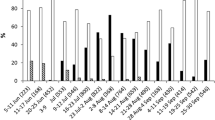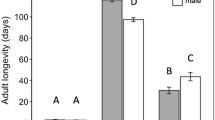Abstract
As part of a general risk assessment study weinvestigated the overwintering abilities ofTrichogramma brassicae Bezd. (Hym.: Trichogrammatidae) in Northern Switzerland. Eggs of six host species parasitized by T. brassicae were exposed under outdoor conditions every two weeksbetween 26 September and 7 November 1998. Wefound that T. brassicae is able tooverwinter successfully on six lepidopteranspecies in the families Tortricidae, Noctuidae,Plutellidae, Pyralidae and Crambidae. Between75 and 100% emergence was observed in thefollowing spring for all of the six tested hostspecies exposed on 26 September. On laterexposure dates, spring emergence decreasedsignificantly and no development of T. brassicae offspring occurred from host eggsparasitized on 7 November.Emergence of T. brassicae from eggs ofEphestia kuehniella Zeller parasitized atweekly intervals in autumn 1999 occurred in thesame year until the end of October if the eggswere parasitized by 10 September. All offspringfrom eggs that were parasitized from 17September onwards went into diapause. Springemergence of T. brassicae adults wasobserved between end of April and beginning ofMay both in 1999 and 2000. Fecundity of T.brassicae females that overwintered on E.kuehniella was not significantly different fromthe fecundity of control females that werereared without diapause under optimalconditions at 25 °C. Our resultsdemonstrate that the egg parasitoid T.brassicae is able to overwinter successfullyin Northern Switzerland and has the potentialto establish in Switzerland. As a result,potential non-target effects are not locallyrestricted but may occur on a largegeographical scale.
Similar content being viewed by others
References
Andow, D.A. and D.R. Prokrym, 1991. Release density, efficiency and disappearance of Trichogramma nubilale for control of European corn borer. Entomophaga 36: 105–113.
Andow, D.A., C.P. Lane and D.M. Olson, 1995. Use of Trichogramma in maize – estimating environmental risks. In: H.M.T. Hokkanen and J.M. Lynch (eds), Benefits and risks of introducing biocontrol agents. Cambridge University Press, New York. pp. 101–118.
Bigler, F., S. Bosshart, M. Waldburger and M. Ingold, 1990. Dispersal of Trichogramma evanescens Westw. and its impact on parasitism of eggs of Ostrinia nubilalis Hbn. Mitt. Schweiz. Entomol. Ges. 63: 381–388.
Boivin, G., 1994. Overwintering strategies of egg parasitoids. In: E. Wajnberg and S.A Hassan (eds), Biological control with egg parasitoids. CAB International, Wallingford. pp. 219–244.
Burbutis, P.P., G.D. Curl and C.D. Davis, 1976. Overwintering of Trichogramma nubilale in Delaware. Environ. Entomol. 5: 888–890.
Civeyrel, L. and D. Simberloff, 1996. A tale of two snails: is the cure worse than the disease? Biodiv. Conserv. 5: 1231–1252.
Clausen, C.P., 1940.Entomophagous insects. McGraw-Hill, New York. 688 pp.
Corbett, A. and J.A. Rosenheim, 1996. Impact of a natural enemy overwintering refuge and its interaction with the surrounding landscape. Ecol. Entomol. 21: 155–164.
Fulmek, L., 1955. Wirtsbereich von Trichogramma evanescens Westw. und Tr. minutum Ril. Anz. Schädlingskunde 8: 113–116.
Howarth, F.G., 1991. Environmental impacts of classical biological control. Annu. Rev. Entomol. 36: 485–509.
Laing, J.E. and J.E. Corrigan, 1995. Diapause induction and post-diapause emergence in Trichogramma minutum Riley (Hymenoptera: Trichogrammatidae): the role of host species, temperature, and photoperiod. Can. Entomol. 127: 103–110.
Li, L.Y., 1994. Worldwide use of Trichogramma for biological control on different crops: a survey. In: E. Wajnberg and S.A Hassan (eds), Biological Control With Egg Parasitoids. CAB International, Wallingford. pp. 37–53.
Louda, S.M., D. Kendall, J. Connor and D. Simberloff, 1997. Ecological effects of an insect introduced for the biological control of weeds. Science 277: 1088–1090.
Lynch, L.D., H.M.T. Hokkanen, D. Babendreier, F. Bigler, G. Burgio, Z.H. Gao, S. Kuske, A. Loomans, I. Menzler-Hokkanen, M.B. Thomas, G. Tomasini, J.K. Waage, J.C. van Lenteren and Q.Q. Zeng, 2001. Insect Biological Control and non-target effects: a European perspective. In: E. Wajnberg, J.K. Scott and P.C. Quimby (eds), Evaluating indirect ecological effects of biological control. CAB International, Wallingford. pp. 99–125.
Orr, D.B., C. GarciaSalazar and D.A. Landis, 2000. Trichogramma nontarget impacts: a method for biological control risk assessment. In: P.A. Follett and J. J. Duan (eds), Nontarget effects of biological control. Kluwer Academic Publishers, Norwell, USA. pp. 111–125.
Overholt, W.A. and J.W. Smith Jr., 1990. Colonization of six exotic parasites hymenoptera against Diatraea grandiosella (Lep.: Pyralidae) in corn. Environ. Entomol. 19: 1889–1902.
Pizzol, J. and J. Voegele, 1988. The diapause of Trichogramma maidis Pintureau and Voegele in relation to some characteristics of its alternative host Ephestia kuehniella Zell. Colloques De l'INRA 48: 93–94.
Simberloff, D. and P. Stiling, 1996. How risky is biological control? Ecology 77: 1965–1974.
Smith, S.M., 1996. Biological control with Trichogramma: Advances, successes, and potential of their use. Annu. Rev. Entomol. 41: 375–406.
Thomson, M.S. and R.E. Stinner, 1989. Trichogramma spp. (Hymenoptera: Trichogrammatidae): field hosts and multiple parasitism in North Carolina. J. Entomol. Sci. 24: 232–240.
Tian, K.F., R.X. Yang, Y.L. Jiang, K.F. Tian, R.X. Yang and Y.L. Jiang, 1998. Study of the overwintering dynamics of Trichogramma closterae in nature. Natural Enemies of Insects 20: 106–111.
Van Lenteren, J.C., 2000. Success in biological control of arthropods by augmentation of natural enemies. In: G. Gurr and S. Wratten (eds), Biological control: measures of success. Kluwer Academic Publishers, Hingham, USA. pp. 77–103.
Voegele, J., J. Pizzol and A. Babi, 1988. The overwintering of some Trichogramma species. Colloques De l'INRA 43: 275–282.
Williams, L. and T.E. Martinson, 2000. Colonization of New York vineyards by Anagrus spp. (Hymenoptera: Mymaridae): overwintering biology, within-vineyard distribution of wasps, and parasitism of grape leafhopper, Erythroneura spp. (Homoptera: Cicadellidae), eggs. Biol. Control 18: 136–146.
Zaslavskii, V.A. and T. Umarova Ya, 1990. Environmental and endogenous control of diapause in Trichogramma species. Entomophaga 35: 23–29.
Author information
Authors and Affiliations
Rights and permissions
About this article
Cite this article
Babendreier, D., Kuske, S. & Bigler, F. Overwintering of the egg parasitoid Trichogramma brassicae in Northern Switzerland. BioControl 48, 261–273 (2003). https://doi.org/10.1023/A:1023661420247
Issue Date:
DOI: https://doi.org/10.1023/A:1023661420247




